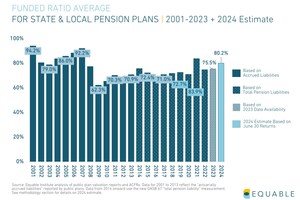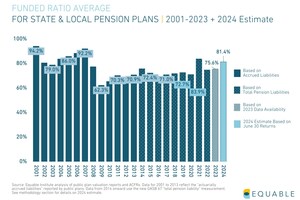Proposed changes by the Oklahoma House to the retirement benefits for members of Oklahoma Public Employees Retirement System would negatively impact overall retirement security for members, while amended Senate Bill would improve retirement income security overall
NEW YORK, April 25, 2022 /PRNewswire/ -- Equable Institute has issued Retirement Security Policy Scores for both the House and Senate versions of Oklahoma House Bill 2486 (HB2486).Passed by the House on March 28, 2022, with the goal of improving employee recruitment, the bill proposes re-opening the defined benefit pension plan offered to members of the Oklahoma Public Employees Retirement System previously closed in November 2015 for current members enrolled in the OPERS defined contribution plan and all future new hires. Awaiting a vote on the Senate floor, the amended version of HB2486 would keep the current defined contribution plan open and increase contribution rates from an up to 7% employer match to an up to 10% employer match.
The current plan for OPERS members serves members moderately well, scoring 72.7% of available points on the Retirement Security Report matrix. When evaluated for key metrics of retirement security, HB2486 (House) scores 37.5% of available benefit points overall, leading to an overall assessment that it would only "does not serve members well." HB2486 (Senate) scores 83.6% of available points, with a qualitative assessment of "serves members well."
RETIREMENT SECURITY POLICY SCORE:
OKLAHOMA HOUSE BILL 2486, HOUSE ADOPTED AND SENATE AMENDED VERSIONS
OVERALL RETIREMENT BENEFIT SCORE |
|||
Current Plan |
HB2486 (House) |
HB2486 (Senate) |
|
72.7% of available points |
37.5% of available points |
83.6%of available points |
|
OVERALL ASSESSMENT |
|||
Current Plan |
HB2486 (House) |
HB2486 (Senate) |
|
Serves Members Moderately Well |
Does Not Serve Members Well |
Serves Members Well |
|
Equable Institute has analyzed the proposed changes using it's open-source scoring methodology from the Retirement Security Report to measure how changes to benefits would affect current and future retirement plan members. The score factors in whether benefits would reach an income adequacy target (70% replacement of pre-retirement earnings), the availability of inflation protection, and the flexibility and mobility of the proposed plan.
According to the analysis, workers enrolled in the plan proposed in HB2486 (House) would receive lower annual retirement earnings compared to the current plan, while the plan proposed in HB2486 (Senate) would result in higher earnings for all members. However, in exchange the proposed House plan could provide inflation adjusted benefits (in the future), while the Senate version would not.
Under HB 2486 (House), Medium Term Workers (those with 10-20 years of service) will see the largest decreases in yearly earnings (-$3,061 decrease in yearly earnings, on average), while Full Career Workers (those with more than 20 years of service will see the smallest overall decrease in benefits should this plan be enacted (-$962 decrease in yearly earnings, on average). Only workers who enter OPERS at the age of 40 and work for more than 20 years will see any positive change in benefit value under HB2486.
Under HB2486 (Senate), all workers would see a significant increase in yearly earnings. Full Career Workers will see the largest increase (+$11,566 per year on average). In the aggregate, Medium Term and Short Term Workers will see yearly benefit value increases of +$4,466 and +$1,711, respectively.
"There certainly is room to improve the benefit value current public employees' retirement plan in Oklahoma," said Equable Executive Director Anthony Randazzo. "However, the version of HB2486 passed in the House would actually reduce benefit values for most if not all future members of the OPERS retirement system. While the version currently being considered in the Senate does not offer a choice of benefits that might expand the range of paths to retirement income security for future OPERS members, it does improve on the status quo by raising employer contribution rates."
A full analysis and extended scorecards with benefit breakdowns by worker class, tenure and age of entry are available for both versions of HB2486 here. The existing plan's Retirement Security Scorecard can be found in the Retirement Security Report's interactive database here.
RATINGS KEY
Qualitative Rating |
Score Range |
Serves Members Well |
75% to 100% of available benefits score points |
Serves Members Moderately Well |
50% to 74.99% of available benefits score points |
Does Not Serve Members Well |
0% to 49.99% of available benefits score points |
ABOUT THESE SCORES
These scores are based on the averages for 25-year-old entrant and 40-year-old entrant with average starting salaries. This analysis is intended to measure the factors that are most important for measuring retirement income adequacy. It is reasonable to compare plan changes against the status quo, but the most fundamental question is whether any retirement plan (the existing benefits or proposed adjusted benefits) is providing retirement income security to all members of the plan. These scores are based on a comparison against a standard benchmark for retirement income adequacy, but there are other reasonable benchmarks too. We've made additional charts available at https://equable.org/oklahoma-house-bill-2486-retirement-security-policy-scores that show how the proposed benefits meet different standards of adequacy.
While our scoring system is designed for maximum objectivity to highlight the material impact of policy changes, Equable does not issue Retirement Security Scorecards for any bills for which we have provided technical assistance to ensure the neutrality of our analysis and we do not endorse any particular retirement plan design.
ABOUT EQUABLE INSTITUTE
Equable Institute is a bipartisan non-profit that works with public retirement system stakeholders to solve complex pension funding challenges with data-driven solutions. We exist to support public sector workers in understanding how their retirement systems can be improved, and to help state and local governments find ways to both fix threats to municipal finance stability and ensure the retirement security of all public servants.
Equable.org | Twitter: @EquableInst | Facebook: @EquableInstitute | Instagram: @EquableInst
SOURCE Equable Institute

WANT YOUR COMPANY'S NEWS FEATURED ON PRNEWSWIRE.COM?
Newsrooms &
Influencers
Digital Media
Outlets
Journalists
Opted In





Share this article